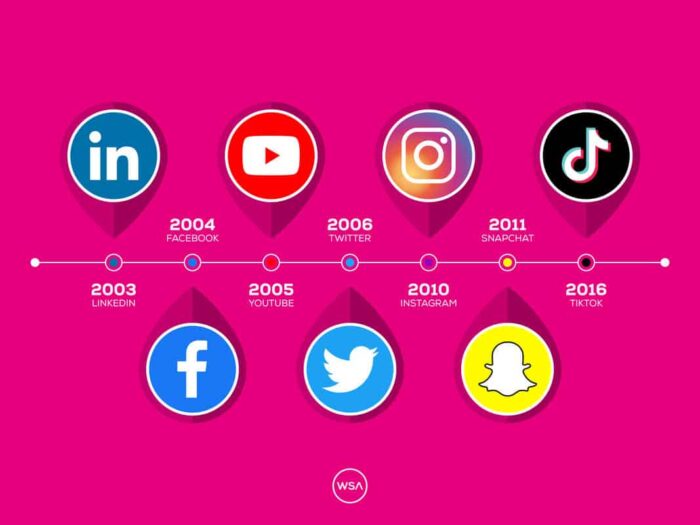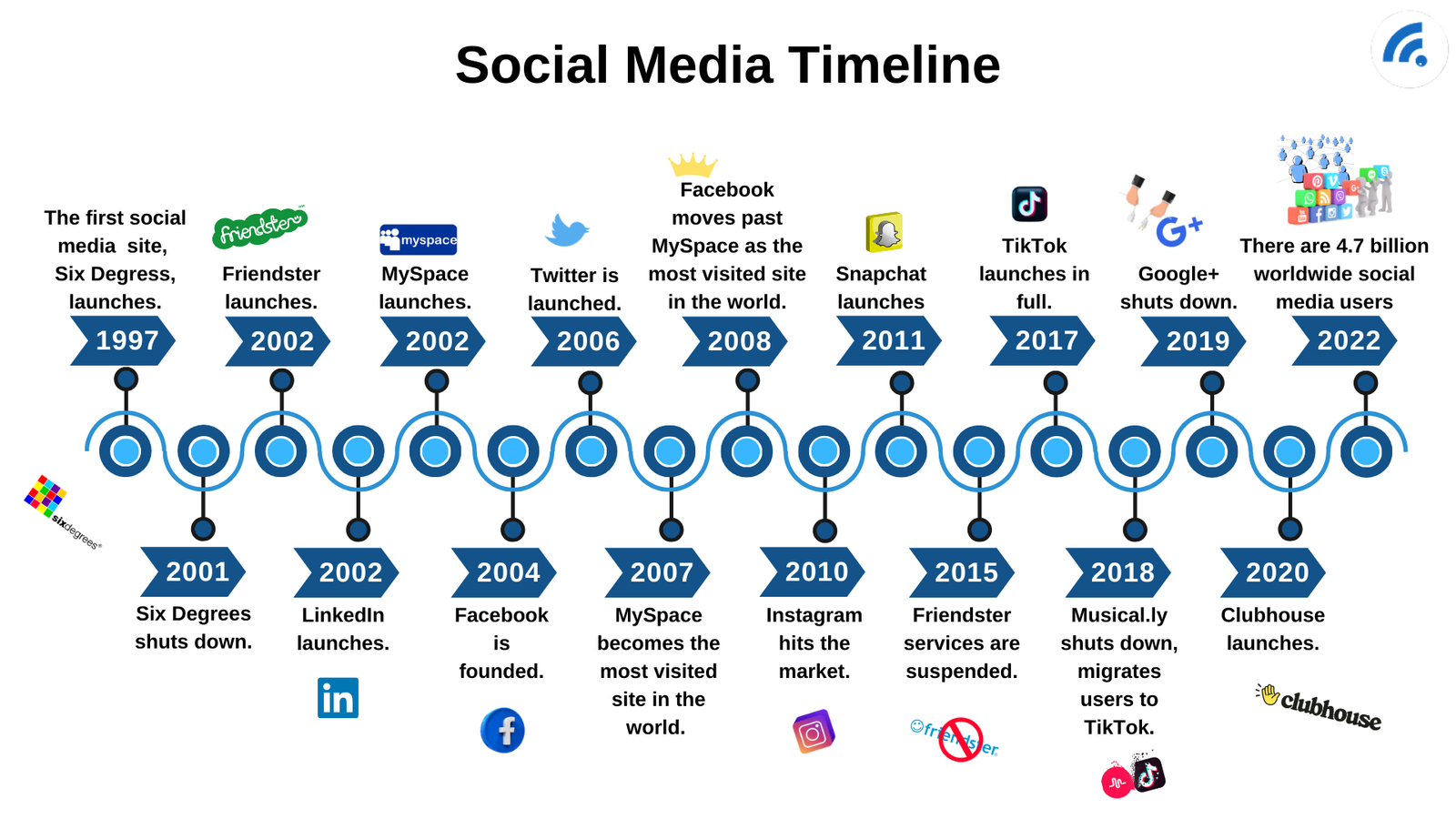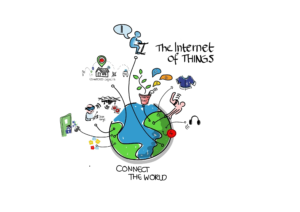The Complete Evolution of Social Media Platforms and Their Global Impact

The complete evolution of social media platforms from early online communities to global influencers has profoundly reshaped how we communicate and interact globally. Imagine a world without instant connection with friends across continents, without the ability to share experiences in real-time, or without businesses leveraging these platforms to reach their target audiences. This evolution encompasses diverse platforms, each with its own unique features and impact. This article explores the complete evolution of social media, from its early days to its pervasive influence on modern society, identifying key milestones, trends, and challenges along the way. It will also discuss the ongoing impact and explore strategies to make the most of this dynamic space.
1. The Genesis of Social Media: Early Platforms and Pioneers
1.1 The Dawn of Online Communities
The concept of social media, as we know it today, emerged from the very early days of the internet. Before the explosion of platforms we see today, early online forums and bulletin board systems provided a digital space for interaction. These platforms laid the groundwork for future social media giants by allowing users to connect and share information. They were often moderated by a single administrator. These early examples demonstrated the potential for online communication but lacked the scalability and features of modern platforms.
1.2 The Rise of Social Networking Sites
The 2000s saw a surge in social networking sites, marking a significant leap in the evolution of social media. Platforms like Friendster, MySpace, and Xanga introduced profile pages, friend requests, and the ability to share personal updates and connect with others who shared similar interests, which was a landmark moment in this space.
1.3 Key Features and Impact
These early pioneers introduced core features that would become staples of subsequent platforms, like user profiles and the ability to connect with others. These sites fostered a sense of community and allowed individuals to share their lives and activities with a wider audience.
1.4 Limitations and Challenges
While these early platforms were groundbreaking, they often faced challenges in terms of privacy and user experience. Design and scalability were often problematic. These early social networks laid the foundation for future growth and innovation, demonstrating the desire for online connection and community sharing, but their limitations highlighted the need for innovation and improvements.
1.5 The Transition to Mobile
The rise of smartphones fundamentally changed the social media landscape. The increased mobile accessibility gave rise to platforms designed for mobile use, making social media more accessible and integral to daily life.
2. The Social Media Explosion: Facebook and Beyond
2.1 The Rise of Facebook
Facebook, launched in 2004, dramatically altered the social media landscape. Its intuitive design and emphasis on user-generated content made it quickly accessible to a wide range of users. The platform redefined the concept of online social networking. It facilitated the sharing of personal updates, photos, videos, and other forms of content, while also opening avenues for commercial and public discussion.
2.2 The Emergence of Twitter and Microblogging
Twitter, launched in 2006, introduced a new form of social media interaction focused on short-form messages. This model emphasized brevity, conversation, and real-time updates. Twitter fostered public discussion and quickly gained popularity due to its immediacy and accessibility.
2.3 Mobile-First Platforms and their Influence
The increasing adoption of smartphones spurred the creation of mobile-first social media platforms. Instagram, with its focus on visually compelling content, exemplified this trend. These mobile-first platforms highlighted the importance of aesthetics and user experience in an increasingly mobile-centric world.
2.4 Influence on Businesses and Marketing
Social media platforms have transformed business and marketing strategies. Businesses now leverage these platforms to engage with customers, promote products, and build brand loyalty.
2.5 Data Privacy and Security Concerns
The increasing reliance on social media platforms has raised concerns about data privacy and security. The collection and use of user data have come under scrutiny, requiring platform owners to address user concerns and implement safeguards.
3. The Global Reach of Social Media
3.1 Globalization and Cultural Exchange
Social media platforms have facilitated global communication and cultural exchange on an unprecedented scale. Users from different parts of the world can connect, share ideas, and learn about diverse cultures.
3.2 The Impact of Social Movements
Social media played a pivotal role in several significant social movements, providing a platform for mobilization and communication. Users can organize protests, raise awareness about social issues, and mobilize support for causes.
3.3 Economic Impact and Opportunities
Social media has profoundly impacted the global economy, creating new opportunities for businesses to reach customers and expand their market reach. E-commerce businesses are leveraging social media marketing.
3.4 Challenges in Global Reach
Despite the advantages, social media platforms also face challenges related to censorship, the spread of misinformation, and cultural biases.
3.5 Localization and Adaptation
Platforms must adapt to the cultural nuances of various regions to maintain their appeal and relevance.
4. The Future of Social Media Platforms
4.1 Technological Advancements
Artificial intelligence and other emerging technologies are poised to further revolutionize social media platforms, making them more personalized and engaging for users. AI-powered recommendations and personalized content experiences are being introduced to enhance user engagement.
4.2 Evolving User Expectations
Users are increasingly demanding more personalized experiences and privacy protections from social media platforms. Personalized content experiences are important.
4.3 The Need for Responsible Use
The responsibility for using social media platforms ethically and responsibly lies with both users and platform providers. Combating misinformation and hate speech is a global concern.
4.4 Emerging Social Media Trends
New social media trends, like the rise of short-form videos, virtual reality, and the metaverse, are reshaping user expectations and altering how we interact with one another digitally. These platforms represent new frontiers for creativity and interaction.
4.5 Addressing the Challenges
Platforms must continue to find ways to address challenges like algorithmic bias, hate speech, and the spread of misinformation while simultaneously responding to the demands of the evolving digital landscape.
Related Post : Cloud Computing in 2024 Latest Advancements and Applications
5. The Impact of Social Media on Businesses
5.1 Social Media Marketing Strategies
Social media has transformed marketing strategies for businesses of all sizes. Companies now have more opportunities to reach their target customers using social media marketing strategies that engage customers directly and increase brand loyalty.
5.2 Customer Engagement and Interaction
Businesses can build brand loyalty by engaging with customers on social media and fostering a direct line of communication. Direct engagement promotes better understanding and customer service.
5.3 Brand Building and Reputation Management
Social media platforms serve as powerful tools for building and managing brand reputation. Positive customer experiences improve a brand’s overall reputation, leading to a more positive brand image.
5.4 E-commerce and Retail
Social media platforms are vital channels for e-commerce and retail businesses. They provide opportunities to showcase products and connect with potential customers, driving online sales. Online sales and customer engagement are crucial.
5.5 Challenges and Opportunities
While social media offers numerous opportunities, businesses face challenges like staying up-to-date with trends and managing potential negative feedback.
6. Social Media and the Individual
6.1 Individual Identity and Representation
Social media platforms have changed how individuals represent themselves and their identity to the world. Personal branding and digital personas are now critical components of how people construct their identity online and engage in social networking.
6.2 Mental Health Concerns
While social media offers connectivity, it also raises concerns about mental health, particularly among young people. The pressure to maintain a positive online persona and to engage in superficial interactions can negatively impact mental well-being.
6.3 The Future of Social Media Use
The future of social media use will involve a more nuanced understanding of how these platforms impact individuals and society. Platforms need to address mental health concerns and foster healthy use.
6.4 Social Media and Well-being
The ongoing discussion on social media’s impact on well-being involves an examination of the role that curated online profiles play.
6.5 Strategies for Healthy Social Media Use
Promoting healthy social media habits, fostering positive interactions, and developing critical thinking skills is critical.
7. Case Studies and Examples
7.1 Social Media in Political Campaigns
Social media played a significant role in political campaigns, impacting how candidates connect with voters, raise awareness, and mobilize support.
7.2 The Impact of Social Media on Businesses
Social media has dramatically changed business strategies, from marketing and customer service to fostering stronger brand identities.
7.3 Social Media Movements
Social movements, from political protests to social awareness campaigns, have leveraged social media to mobilize support and raise awareness.
7.4 Social Media and Global Culture
Social media has played a pivotal role in fostering global interactions and understanding of other cultures, broadening our views.
7.5 How Different Platforms Adapt to Cultural Nuances
Successful platforms have adapted to cultural nuances to connect with diverse audiences around the world.
In conclusion, the complete evolution of social media platforms has profoundly reshaped global communication and interaction. From humble beginnings as niche online communities to today’s ubiquitous platforms influencing culture and economies, social media’s impact is undeniable. The future of social media platforms likely involves a blend of technological advancements, evolving user expectations, and the ongoing need to maintain responsible use. To stay ahead of the curve and navigate the challenges and opportunities that this ever-changing landscape presents, understanding the historical context of these platforms and the ongoing trends is paramount. Dive deeper and learn how to leverage social media effectively by taking action now!
Share this content:














Post Comment